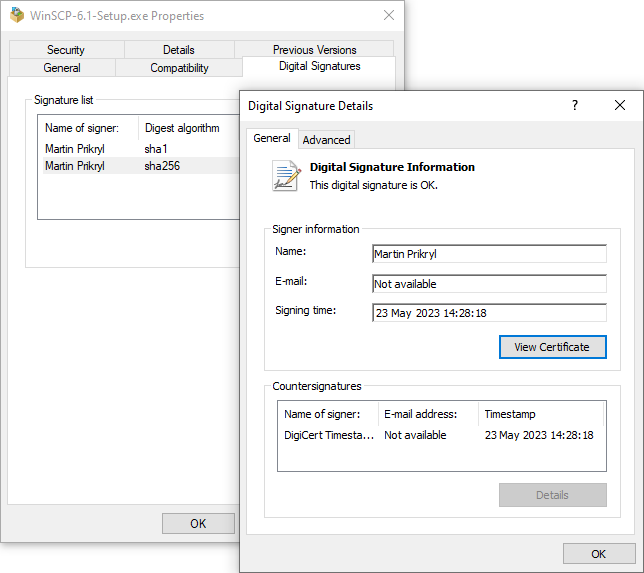This is an old revision of the document!
Installation
This article contains detailed description of downloading and installing WinSCP. You may want to see simplified guide to the process instead.
The most users will prefer installing WinSCP for an easy setup.
Though note that, if you prefer so, you can use WinSCP executable as a portable application with its settings stored in an INI file and no installation required. This configuration is best for using WinSCP from a removable media.
Advertisement
- Obtaining WinSCP
- Running the WinSCP Installation Program
- Upgrading WinSCP
- Downgrading WinSCP
- Removing / Uninstalling WinSCP
- Automating Installation and Uninstallation
- Custom Distribution of WinSCP
- Administration Tasks
- Verifying Integrity of Installer
Obtaining WinSCP
You can obtain WinSCP from the WinSCP download page. You should save the installer to an easily accessible location such as your Microsoft Windows desktop or your My Documents folder.
Running the WinSCP Installation Program
- If you have WinSCP running, close it. The installer will not run if it finds any instance of WinSCP running.
- Open the installation program by double clicking on its icon.
- The WinSCP installer starts. Follow its instructions.
Upgrading WinSCP
To upgrade WinSCP, download the newer version, and then install it. The installation will preserve your configuration, and – if necessary – upgrade it.
Advertisement
The new WinSCP version will be installed in your language, if this particular localization has already been completed. The installation package contains all the translations that were complete at the time of its release. Otherwise you must install the new translation manually, if available. Any translation from your previous WinSCP version will not work with the new version.
When upgrading Portable executable, just replace the executable files with the new version. New version can always read configuration from the old version.
You can check for rare backward incompatible changes.
Downgrading WinSCP
In most cases, you may downgrade in the same way as upgrade (i.e. install the old version over the newer one). However safe way is to uninstall the newer version (while keeping your configuration) and only then install the old version.
Note that some of your configurations may be lost when downgrading. To make sure that you will be able to downgrade, you should backup your configuration before the upgrade.
Removing / Uninstalling WinSCP
To remove WinSCP, go to Control Panel > Programs > Uninstall a program.
On Windows 10, you can also use Settings > System > Apps & features.
During the removal, WinSCP will ask if you want to remove WinSCP configuration and other data stored on your computer.
Automating Installation and Uninstallation
WinSCP uses Inno Setup as installer. It lets you use optional command-line parameters to automate the installation.
You can use following parameters to automate the installation:
/LANG=language- Runs the installer using the specified language. For thelanguage, use the Code from translations page./SILENT- Runs the installer without any prompts (with the exception of error messages, etc.). Default selections are used for destination folder, components, etc./VERYSILENT- As/SILENT, but without showing the progress window./NORESTART- Instructs installer not to reboot even if it’s necessary./LOG="filename"- Causes Setup to create a log file./LOADINF="filename"- Instructs Setup to load the settings from the specified file after having checked the command line. This file can be prepared using the/SAVEINFparameter./SAVEINF="filename"- Instructs Setup to save installation settings to the specified file./NOCLOSEAPPLICATIONS- Prevents Setup from closing applications using files that need to be updated by Setup.
See full list of Inno Setup setup command line parameters.
WinSCP uninstaller (unins000.exe in WinSCP installation directory) has the same parameters as above (except for /LOADINF and /SAVEINF).
See full list of Inno Setup uninstaller command line parameters. When running uninstaller silently, configuration and other data stored on your computer are not removed.
Advertisement
Custom Distribution of WinSCP
Learn how to create a custom distribution of WinSCP.
Administration Tasks
Learn how a system administrator can restrict or enforce certain functionality of the application.
Verifying Integrity of Installer
Optionally, as a security measure, you can verify an integrity of the WinSCP installer binary before installing.
In Windows Explorer display Properties of the installer and verify a signature on the Digital Signatures tab. The installer should be signed by “Martin Prikryl”.
- The certificate used to sign the latest installers has an SHA-1 hash
0b 3d 1c 21 77 3b 6f d7 8f bf 41 8a 5e a2 d9 1c 0e 51 44 d3and is valid from 2016-11-17 to 2020-01-23. - The certificate that was used to sign old installers has an SHA-1 hash
4a 14 66 81 58 d7 9d f2 ac 08 a5 ee 77 58 8e 5c 6a 6d 2c 8fand was valid from 2016-01-03 to 2016-10-23.
The certificate can also be displayed on the User Account Control prompt, when starting the installer.
You can also verify file integrity manually. Find checksums of the installer binary in the release notes or on the installer download page. You can cross-check the checksum against a copy of the release notes on the SourceForge server. Use the certutil tool to calculate a SHA-256 checksum of the downloaded installer and compare it.
C:\...>certutil -hashfile WinSCP-6.3.3-Setup.exe SHA256 SHA256 hash of file WinSCP-6.3.3-Setup.exe: 928dd0b8818b49106c344c937aad68d7893def75a5bf65d79aeb2cd566f239f7 CertUtil: -hashfile command completed successfully.
Advertisement
